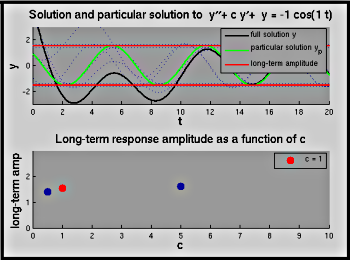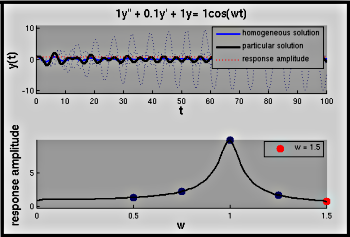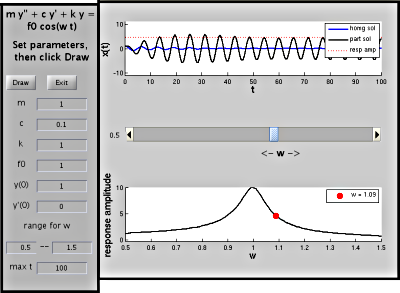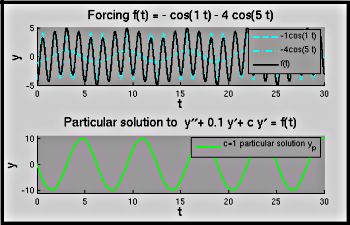Model Description
As indicated in the circuit demonstration,
we consider an RLC circuit, shown below, as a model for a radio tuner.

Here the input voltage \(E(t)\) is the signal that is being received by
the tuner. We expect that this will be a combination of a number of
different radio signals that are broadcast with different frequencies.
\(R\), \(L\) and \(C\) are the resistance, inductance and capacitance in
the circuit. We can adjust the capacitance \(C\) to select one
frequency in the input—that is, by changing \(C\) we can make the
(long-term) behavior of the system mirror only one of the
frequencies in the input function \(E(t)\).
ODE Model
As indicated in the circuit demonstration, we let \(I\) be the current in the circuit. Then Kirchoff's second law (that the sum of the voltage drops in the circuit must equal the input voltage) and the elementary laws of electricity give \[ L\,I'' + R\,I' + \frac{1}{C}\,I = E'(t) \] (as shown in [1] or [2]).
Following [1], we might take \(L = 1\)H (Henry, the unit of inductance) and \(R = 0.1\Omega\) (Ohms, the unit of resistance). Then, we may suppose that the input voltage is a combination of several carrier signals with different frequencies; for example, we might take \(E(t) = -\cos(t) - 4\cos(5t)\). For initial conditions, if there is initially no current, \(I(0) = 0\) and \(I'(0) = (E(0) - q_0/C)/L\). The question for the tuner is how to pick \(C\) so that \(I(t)\) looks like only one of the terms in the input \(E(t)\).
This question can be rephrased slightly by considering the response to a single input frequency: if \(E(t) = -\cos(\omega t)\), and asking what value of \(C\) will produce the largest amplitude response (and, correspondingly, what values produce a very small response). Turning the question around slightly, we could also ask for a given value of \(C\) what value(s) of \(\omega\) have the largest response. The demonstrations below explore these questions.
Matlab Demos
Our demos collection:
- Response_Simple.m:
A demonstration that shows the solution to the initial value problem
\(a y'' + b y' + c y = -f_0\cos(\omega t)\) for given values of
\(a\), \(b\), \(c\), \(f_0\) and \(\omega\). The full solution for
the problem with specified initial conditions is graphed along with
the particular solution and lines showing the amplitude of the
long-term solution. At the same time the long-term amplitude is
shown as a function of one of the parameters \(c\) or \(\omega\).
After graphing these for one value of \(c\) or \(\omega\) it pauses,
and then plots additional solutions to show the response curve and
solutions for a range of values of the parameter.
[show
figure]

- Response_Simple2.m:
A very similar demonstration to
Response_Simple.m. In this case, the homogeneous and particular solutions are graphed in the upper window and amplitude vs. frequency in the lower. Results are shown for a list of frequencies, with pauses between each. This differs fromResponse_Simple.min that it does not show variation as a function of the spring (inductance) term \(k\) (or \(c\)), some parameter settings, the solutions being graphed, and its treatment of the maximum amplitude in the case of resonance (where the response amplitude graphed is the maximum amplitude in the solution graph). [show figure]
- Response_Curve_GUI.m:
A demonstration that shows homogeneous and particular solutions, and
the amplitude of the response (particular solution) as \(\omega\)
varies. The solutions and response are shown in an animation over a
range of values of \(\omega\). Thereafter behavior is controlled by a
GUI control panel that allows the parameters in the system and range
of values for \(\omega\) to be set and a slider that allows values
of \(\omega\) to be selected.
[show
figure]

- Response_Multiple.m:
A demonstration that shows the particular solution to the problem
\(a y'' + b y' + c y = -f_0\cos(\omega_0 t) - f_1\cos(\omega_1 t)\)
for given values of \(a\), \(b\), \(f_0\), \(f_1\), \(\omega_0\) and
\(\omega_1\), for a list of values of \(c\). The forcing term and
its components are graphed in a top sub-plot, and the long-term
behavior of the system (the particular solution) in the bottom.
There is a pause between each value of \(c\), so that we can see
that different values of \(c\) may result in a response which is
primarily composed of one or the other of the input frequencies.
[show
figure]

Looking at the Model
Some questions that may be worth considering:
- Qualitatively, where is the peak in the amplitude response graph for a given equation? How are its location and value related to the choice of the damping coefficient (\(b\), or \(c\)): the coefficient of \(y'\)?
- Considering the case of inputs with multiple frequencies, how is the response seen there related to the simple one input case? To the response curves we see for a single input frequency?
